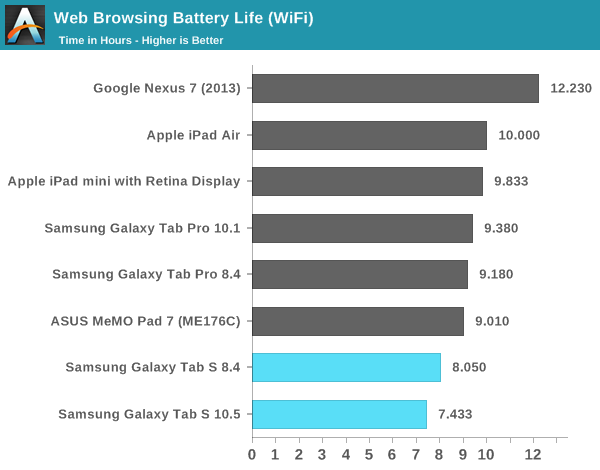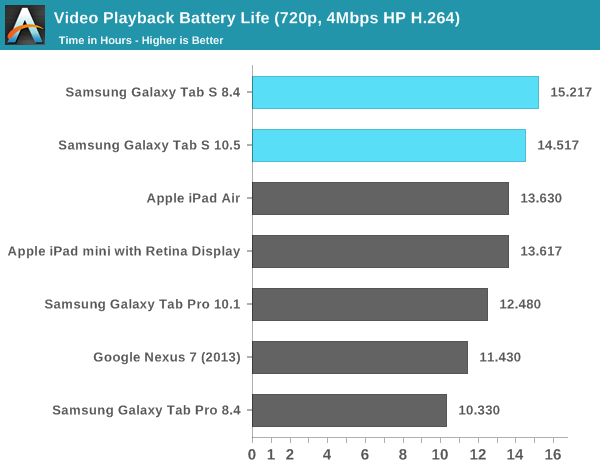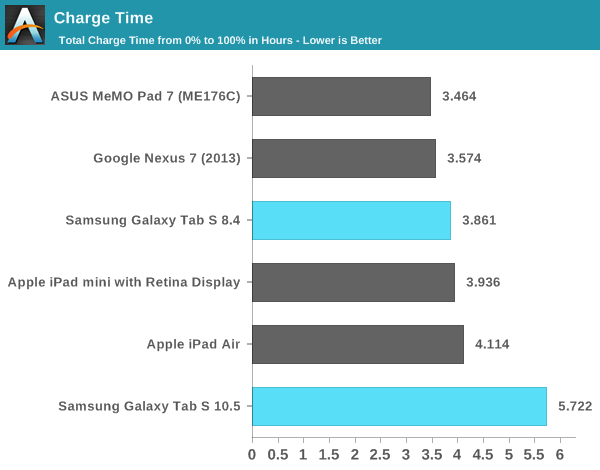Samsung Galaxy Tab S Review (10.5 & 8.4-inch)
by Anand Lal Shimpi on June 24, 2014 9:00 AM EST- Posted in
- Tablets
- Samsung
- Mobile
- Galaxy Tab S
Battery Life
Both Galaxy Tab Ses feature somewhat small batteries, a downside to pursuing a very thin chassis. The 10.5-inch model gets a 30Wh battery compared to 32.4Wh in the iPad Air, while the 8.4-inch model only has an 18.6Wh battery compared to 23.8Wh for the iPad mini with Retina Display.
For our web browsing workload, the battery size and power requirements of displaying mostly white web pages on a high resolution AMOLED display result in substandard battery life. Both devices deliver around 8 hours on a single charge, which isn’t bad in a vacuum - it’s just a regression compared to the Galaxy Tab Pro and far behind the other competition.

The story changes dramatically however once we look at video playback battery life:

Our video playback test is perfect for an AMOLED display as the final Harry Potter movie ends up having a lot of dark scenes in it. With only a small percentage of the display showing white, display power is reduced substantially, resulting in the best video playback battery life of any tablet we’ve ever tested. Even the tiny 8.4-inch Galaxy Tab S can last over 15 hours on a single charge.

Charge time isn’t particularly fast on any of the devices, but the 10.5-inch model in particular takes a while to make it to a full charge. The 10.5 will reach a 90% charge in just under 4 hours, but to make it to 97% takes another hour and the last 3% takes another 42 minutes on top of that. Usable charge time is competitive, but if you’re obsessive about always charging to 100% the 10.5-inch model does take a while to get there.










98 Comments
View All Comments
dylan522p - Tuesday, June 24, 2014 - link
All points are not equal, Saturation and gamut are far mmore important.name99 - Wednesday, June 25, 2014 - link
This really seems like the narcism of small differences.Judging from Anand's comments, both displays are spectacular, and more fruitful avenues of competition would appear to be based on features other than improving the metrics Anand is measuring.
Given what appears to be substantially lower power (when displaying dark scenes) Samsung comes out ahead --- of course this is of little value if they do worse on displaying white scenes, which also appears to be the case, and if (like me) you spend most of your time reading black text against a white background.
In future whoever gets to variable refresh first (both to save power, and to display 24 and 48 fps content at the native rate) will have achieved a more useful advantage. Likewise I suspect that for at least some purposes an available refresh rate of higher than 60 fps (maybe 72, maybe 90 or even 120) may be valuable --- I don't know how high you need to go before motion (especially the difficult cases like horizontal pans) never judders.
lilo777 - Tuesday, June 24, 2014 - link
Let me just quote DisplayMate - a well know specialist in display evaluations: "Based on our extensive Lab tests and measurements, the Galaxy Tab S is the Best Performing Tablet Display that we have ever tested, not surprisingly with performance that is almost identical to the OLED Galaxy S5 Smartphone that we recently tested and found to be the Best Performing Smartphone Display."While I appreciate AnanTech reviews very much for their comprehensiveness when it comes to displays I prefer the opinion of the specialists in the field. You can read DisplayMate's full review here: http://www.displaymate.com/OLED_Tablet_ShootOut_1....
dylan522p - Tuesday, June 24, 2014 - link
You mean biased as fuck? He calls 113% gamut "great" and he says the saturation is also great look at the numbers and you see it's bullshit.the_ether - Tuesday, June 24, 2014 - link
Where does he say that?From what I can see, in reference to a gamut of 113% he has said, "Slightly Too High," and that is in reference to sRGB and the screen being in 'Basic Mode' instead of 'Photo Mode'. When in 'Photo Mode', the Samsung screen is said to be within 106% of the larger, Adobe RGB gamut.
Of course, a wide gamut capability is pointless without accuracy and according to his tests, the Samsung 10.5 screen is either "Very good" or "Excellent."
hung2900 - Tuesday, June 24, 2014 - link
I agree with the_either. Displaymate rated carefully and not biased.Color gamut:
- Air 108%: very good.
- Tab S 10.5 113%: slightly too high.
Absolute Color Accuracy Average Color Error:
- Air 3.2 JNCD Very good.
- Tab 10.5 2.1 JNCD Excellent
Absolute Color Accuracy Largest Color Error
- Air 7.9 JNCD Good.
- Tab 10.5 4.0 JNCD Very good.
So nothing wrong when Displaymate said Tab S has better color accuracy and is the best tablet display yet in market when combining with other factors.
P/s sorry for my rude comment above
the_ether - Tuesday, June 24, 2014 - link
Thank you hung2900.mhannigan - Wednesday, June 25, 2014 - link
You didn't read. One of the things he makes a point of several times is the ability to change the screen calibration. He notes that many people find the increased saturation pleasing to the eye - I do. But if you don't like it, there are other options, two of which are spot on with industry standard color gamut.ddriver - Tuesday, June 24, 2014 - link
It is hard to take anand reviews seriously just looking at their "CPU benchmark" choices, plus their heavy bias toward apple products. DisplayMate go further with testing and are more objective in their conclusions.hung2900 - Tuesday, June 24, 2014 - link
Anand's CPU comparison is so apple-and-orange comparison. Everyone know Sunspider is the mix of Browser optimization, CPU power and how CPU optimized toward browsing. Why didn't he use Chrome to mesure the Sunsipder of iOS?